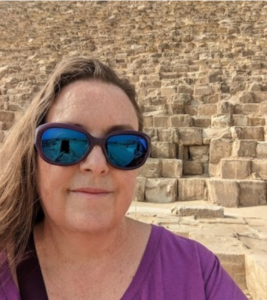
06
MayWashington D.C.: Reconstructing the Ancient Nile and Human Interactions with the River
Registration is Required
Presented by: Dr. Suzanne Onstine, associate professor in the Department of History at the University of Memphis
- 12:00 PM ETWashington, D.C.
- Zoom
- + Add to Calendar
Lecture Information
 For millennia the Nile has played a fundamental role in the growth and expansion of the Egyptian civilization. This extensive river system shaped the landscapes in which the ancient Egyptians lived, worked, died, and were buried, and people’s intimate connection with it strongly influenced where they placed their cities, cemeteries, and temples.
For millennia the Nile has played a fundamental role in the growth and expansion of the Egyptian civilization. This extensive river system shaped the landscapes in which the ancient Egyptians lived, worked, died, and were buried, and people’s intimate connection with it strongly influenced where they placed their cities, cemeteries, and temples.
However, there is still great uncertainty about the exact route of the Nile and whether the river had a single course or multiple branches that were simultaneously active in the past.
While many efforts to reconstruct the ancient Nile drainage system have been conducted in previous years, they have been confined primarily to small study areas, producing maps of fragmented sections of the ancient river. The position and dynamic nature of the entire river channel system remains undiscovered.
Such a poor understanding of the Nile history not only inhibits our ability to map archaeological sites accurately, but also to understand their significance within the wider landscape.
Using remote sensing, geophysical methodologies for ground truthing, and Egyptological research, our team has begun the process of mapping the ancient Nile south of Cairo.
Speaker Bio
 Dr. Suzanne Onstine is an associate professor in the Department of History at the University of Memphis. She received her B.A in anthropology at the University of Arizona and her M.A. and Ph.D. in Near and Middle Eastern civilizations at the University of Toronto.
Dr. Suzanne Onstine is an associate professor in the Department of History at the University of Memphis. She received her B.A in anthropology at the University of Arizona and her M.A. and Ph.D. in Near and Middle Eastern civilizations at the University of Toronto.
Dr. Onstine has worked as an archaeologist in Egypt for more than 25 years. She is a co-principal investigator for the National Science Foundation-funded project entitled “Methodology for Reconstructing Prior River Flow,” and she directs the University of Memphis mission to Theban Tomb 16, the tomb of Panehsy in Dra Abu el-Naga, Luxor. She has published many works on religion and gender in addition to various aspects of work in TT16.